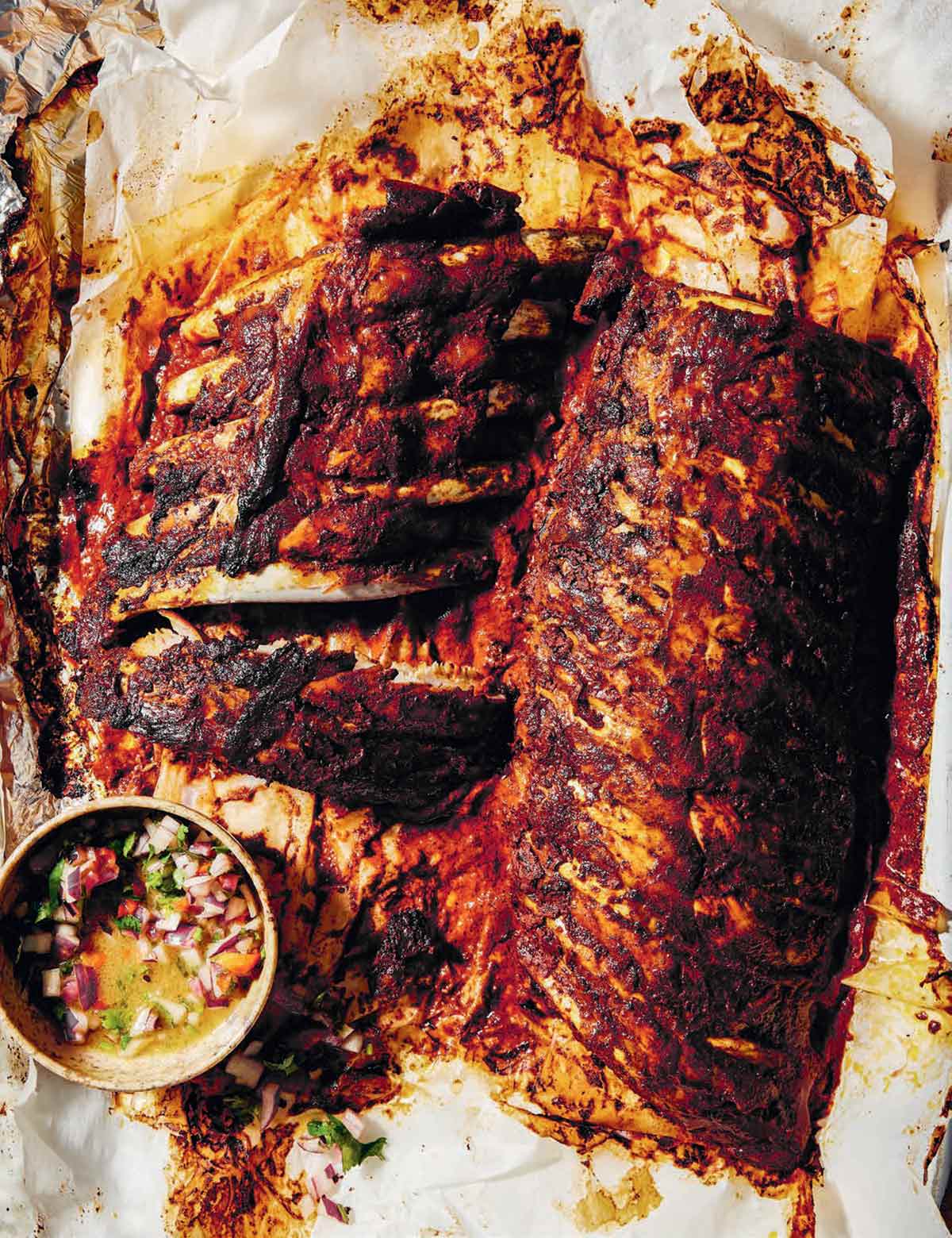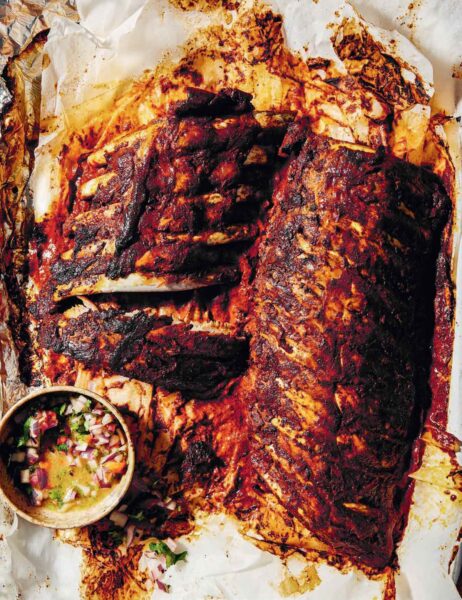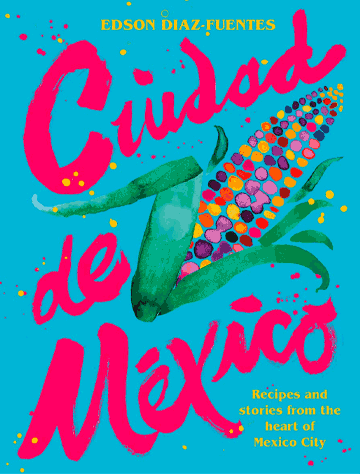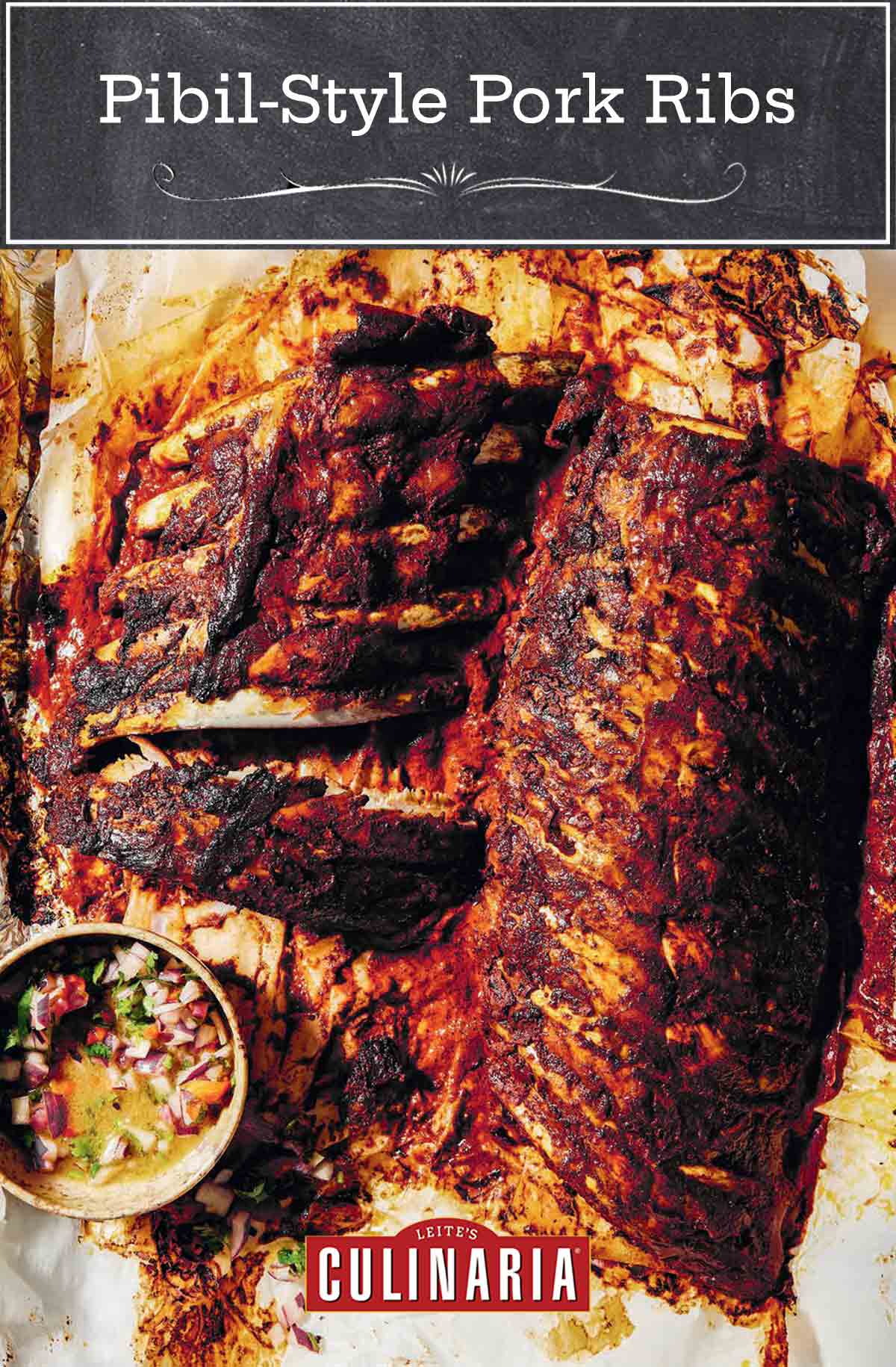
Cochinita pibil is the emblematic dish of Yucatan. Cochinita, the whole suckling pig, is doused in achiote marinade, wrapped in banana leaves, and slow-roasted in a pit. Annatto seeds are used as a natural coloring in the food industry. Achiote paste, a mix of crushed annatto seeds and spices, has a deep, vibrant red color and a unique peppery, musky flavor which pairs beautifully with pork.
Want to Save This?
A word of warning: the habanero chiles used in the marinade and the salsa give these spare ribs a good kick.–Edson Diaz Fuentes

Pibil-Style Pork Ribs
Ingredients
For the pibil marinade
- 5 ounces achiote paste*, crumbled
- Scant 1 cup fresh orange juice
- 3 tablespoons fresh lime juice
- 1 1/2 ounces (about 10 cloves) garlic cloves
- 1 habanero chile, trimmed
- 1 1/2 teaspoons dried Mexican oregano
- 3/4 teaspoon sea salt
For the ribs
- Two racks (2 lbs 4 oz) pork spare ribs
- 1 scant cup water
- Mild vegetable oil, for brushing
For the habanero salsa
- 1 large (9 oz) red onion, finely chopped
- 2 to 4 habanero or Scotch bonnet chiles, finely chopped
- 2 ounces store-bought or homemade pickled red onions, plus 2 tablespoons pickling juice
- Scant 1/2 cup fresh orange juice
- 3/4 teaspoon sea salt, plus more if needed
- 3 tablespoons extra virgin olive oil
- 3/4 ounce fresh cilantro, chopped
For serving
- Black beans (optional)
Instructions
Make the pibil marinade
- Place all the ingredients for the marinade in a blender and blend until smooth.
Marinate the ribs
- Place ribs in a large non-reactive container, such as a glass or porcelain dish. Cover with the marinade and refrigerate overnight.
- Remove ribs from the refrigerator about 1 hour before cooking. Preheat oven to 325°F (160°C) and line a roasting pan with a large piece of aluminum foil, big enough to enclose the ribs.
- Place a large sheet of baking parchment on top of the foil, then place the ribs on the baking parchment. Scrape out any marinade left in the dish and pour it over the top of the ribs, along with the water. Cover with a second piece of baking parchment and wrap the ribs in the paper and foil. Crumple the edges of the foil to seal.
- Place in the oven and bake until the meat is well cooked and falling off the bone, 2 to 2 1/2 hours.
- Increase oven temperature to 350°F (180°C). Lightly brush ribs with oil and bake, in the open parcel, until the top of the meat begins to form a crust, about 20 minutes.
Make the habanero salsa
- While the ribs are cooking, in a bowl, combine red onion, chiles, pickled red onions, pickling juice, orange juice, and salt. Mix well until the salt has dissolved.
- Whisk in the olive oil and leave the salsa to infuse for 10 minutes. Taste to check seasoning and balance, and adjust accordingly with more juice, chiles, or salt if needed. This salsa should be spicy but with a fragrant and citrusy flavor. Add the cilantro just before serving.
- Serve ribs straight from the oven, with habanero salsa, and black beans, if desired, on the side.
Notes
*What is achiote paste?
Achiote (or annatto) seeds are what give cochinita pibil its distinctive coloring. On their own, they don’t have much taste aside from a slight woody pepperiness. In general, the seeds are mixed into a blend of garlic, orange zest, cumin, sea salt, and habanero peppers which come in powdered, paste, or oil forms. If you can’t find paste but do have powdered achiote seasoning, add water (a little at a time) until you have a paste.
Explore More with AI
Nutrition
Nutrition information is automatically calculated, so should only be used as an approximation.
Recipe Testers’ Reviews
We really enjoyed these Pibil-style pork ribs. The aroma in the house was amazing and the finished product didn’t disappoint. I’ve never used achiote paste so I was very excited to try this recipe. It has an aroma similar to a smoky paprika but milder. My habaneros were small so I probably should have used two since it wasn’t noticeable at all in the raw marinade.
I used back ribs, which were tender in 2.5 hours. The finished flavour is mild but definitely present. It pairs perfectly with the salsa. It’s nice to have ribs that don’t have that distinct dry rub texture.
Cochinita pibil is one of my go-to recipes for large groups so I was excited to try these Pibil-style pork ribs. It’s good, really good flavor, but I think the texture could be better. The marinade was more watery (orange juicy) than I was expecting and there was no “scraping” any extra marinade out of the pan as suggested, it just poured right out. I feel like it would have had a better final result if they were finished on the grill or out of the marinade. That would be my only suggestion.
The habanero salsa is a whole different story. It is fantastic as it is. WARNING: It is HOT, but it is also very flavorful. The initial fruity flavor of the habanero complements the marinade on the ribs. I will be using this on chicken and chops as well for sure.













I love this style ribs. After eating Pibil style ribs, I have no deisre to eat barbeque sauce ribs ever again. These are also good on the smoker with a mellow hardwood such as apple.
Thanks, Scott. We completely agree!
How interesting!
I love pibil and I’ve often considered giving it a try but all the recipes I’ve ever found included a banana leaf. That’s what always brought me to a standstill.
And can I ask why the habañero salsa? The restaurant pibil I’ve had has never been spicy. Rich in complex flavors, but hardly piquante.
We hope you give it a try, Rainey. It’s not crucial to serve the salsa with the ribs, but all of our testers did find that it was an excellent addition.